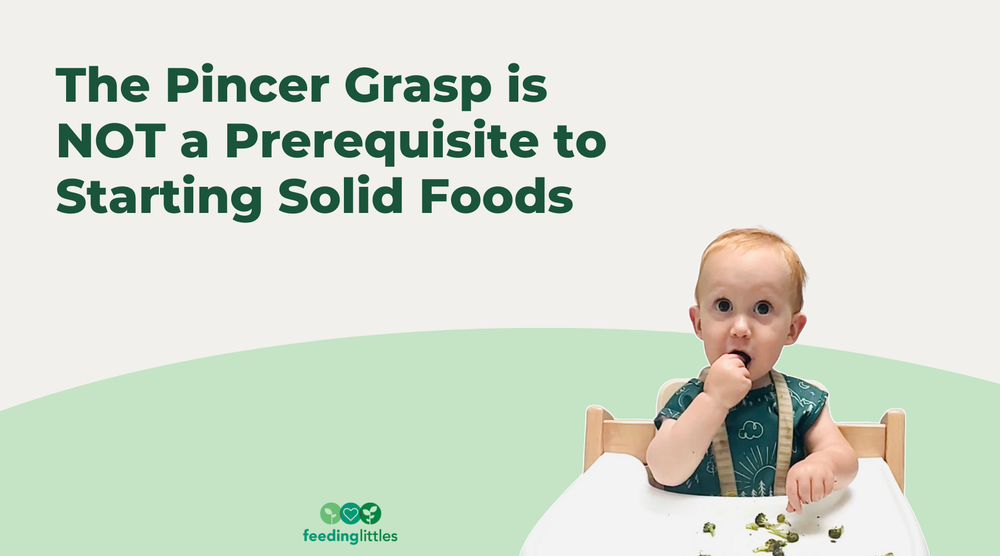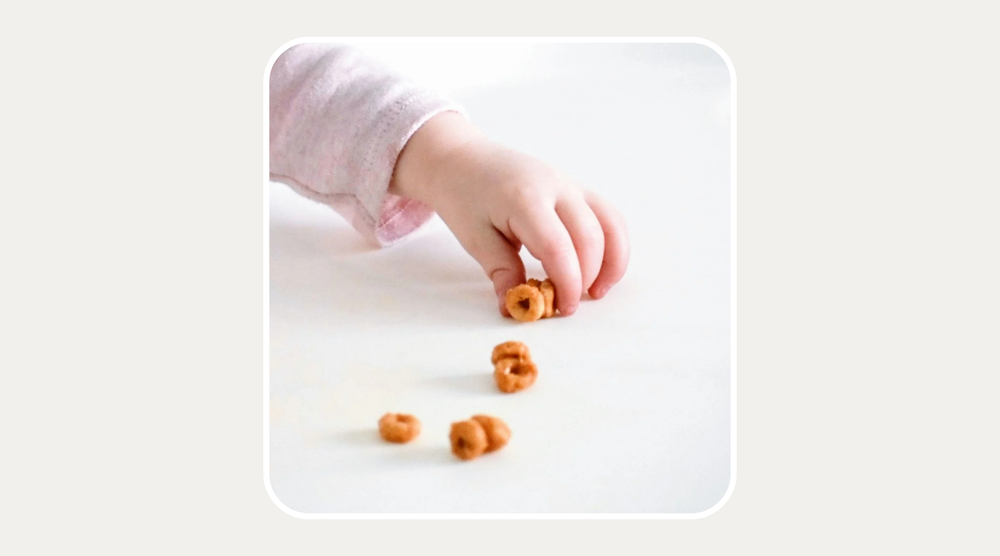
Many parents rely on Facebook support groups for information about all things parenting – feeding, behavior, sleep development, potty training, and even car seat safety. With the influx of resources comes an overload of information, including “rules” or “guidelines” that sometimes aren’t based in evidence. One such example that has been floating around the interwebs is the idea that baby “should be developing a pincer grasp” to be ready for solids.
Disclosure: some links below are affiliate links, which means (at no cost to you) we will make a small commission if you click through and make a purchase via Amazon. Check out our entire Amazon store here. We do not receive sponsorships by companies to promote specific products.
This is simply untrue. A baby does not have to have mastered, or be developing, a pincer grasp to be ready for solid foods.
What’s more, a baby may develop an “emerging” pincer grasp early, but a true pincer grasp takes an extraordinary amount of fine motor skill on baby’s part. It does not fully refine in most cases until 10-12 months. We can’t wait until a true pincer grasp is mastered before offering food because we would be waiting too long.

This “pincer grasp” guideline found in circulating memes and graphics is not documented by any major medical group or health organization. To our knowledge, there is no data to connect this skill to baby’s readiness for solid foods.
Does a pincer grasp help baby eat small pieces? Absolutely. Is it helpful when baby can do it? Totally! Is it an important developmental skill? Yes! However, baby can still pick up larger pieces of foods, usually the shape of a strip or stick, around 6 months. They can also hold onto utensils!
Before we go any further, lets officially define a pincer grasp. The pincer grasp is when baby touches just the end of their index finger to just the end of their thumb to form a circle in her fingers. Many of the grasps that babies use as they develop a pincer grasp allow them to pick up smaller foods, but they’re not technically a perfect pincer until just the index and thumb touch at the ends. Since this is a sophisticated grasp/skill that takes months for babies to develop, it’s something that should not be a pre-requisite to offering solid food.
We of course want baby to begin to develop her pincer grasp so they can pick up peas, quartered grapes, beans, and rice, but don’t be discouraged if your six-month-old (or even your nine-month-old!) hasn’t mastered this skill. It is normal. Remember, a true pincer grasp does not emerge in most babies until 10-12 months.
So, how can you best help your baby develop pincer grasp and fine motor skills in general? Like most things developmental, specific skills build on one another in infancy and childhood. We want to promote baby’s skills early on and foster fine motor development so that baby is ready for eating all shapes of food, coloring, and eventually writing later in life.
No matter the age of your baby, you can do simple activities that help them eventually develop pincer grasp and more mature hand movements. Here are some developmental expectations and ways to help your baby with fine motor development, starting at birth. You’re probably doing a lot of this already – we just wanted to offer specific techniques that we recommend to our clients. Remember, all babies develop a little differently, so contact your pediatrician if you’re concerned about your baby’s progress.
Newborn
Skills:
- Baby has a strong grasp reflex – they can wrap their little fist around your finger.
- Their hands may open as you stretch out their elbows.
Family Activities:
- Touch and massage of both sides of baby’s hands, rub with a soft cloth to teach them the safe meaning of touch from another person.
- Gently stroke the back of your child’s hand to stimulate a reflex that helps babies uncurl their fingers. The sooner babies open up their fingers, the sooner hand play begins.
- Avoid use of infant mittens, as this can slow down hand to face and hand to mouth development. Many parents use mittens to prevent facial scratching due to how fast nails grow, but remember this: your baby was sucking on their fingers during pregnancy. They use that sucking activity to calm and regulate their heart and breathing skills. Allow them to self-regulate using sucking as often as you can.
1-2 Months
Skills:
- The grasp reflex continues.
- Baby can hold an object in their hand briefly if you place it there.
- Baby might try grabbing for a blanket – they practice opening and closing their hand.
Family Activities:
- Place Bright Starts Lots of Links “baby rings” inside your baby’s hand. Allow them to hold a variety of other toys that encourage touching textures and shapes for the development of the hand.
- Place your finger within your baby’s hand and allow them to squeeze and release. This is a great exercise for improve your baby’s awareness of their palms and fingers.
- Keep doing tummy time, chest to chest, and encouraging hands onto the floor or onto a caregiver's chest for hand development skills.
3-5 Months
Skills:
- Baby uses fingers in a grasp, but this does not involve the thumb yet. This starts as early as 3 months of age.
- The grasp reflex disappears and is replaced by what is called sustained voluntary grasp. This is when your baby can purposefully hold onto something, like a teething toy, for a longer period of time.
- Tiny hands begin to accommodate to the shape of an object.
- Sensory tactile awareness within the hand/palm develops. This means that your baby becomes aware of the feeling of items in their hand (soft, hard, squishy, etc.).
Family Activities:
- Practice placing a variety of safe and developmentally-appropriate toys into your baby’s palm and watch as the middle finger (which is the strongest, followed by the ring and little fingers) maintains a grasp briefly. Release is then involuntary, meaning they can’t quite control it.
- Practice grasp and release skills with soft plush toys, plastic or wooden toys, and our favorite toy for use at this stage – the Skwish.
- While in tummy time, which is critical at this age, baby’s palms and fingers are pressing onto the floor and hands are opening, closing and getting stronger in this position.
6 Months
We recommend starting complementary foods around 6 months and when baby is showing readiness signs, including independent sitting on the floor. Follow your baby’s skills, and challenge her to do a more complicated food as they demonstrates readiness signs. For example, if your baby is trying to pick up smaller pieces of food, try cutting the food smaller the next time you serve it!
If your baby seems frustrated at a meal, make sure the food is in a shape and size they can pick up. It is normal for your baby or toddler gets really messy with foods. Even though they can pick food up and feed themselves, mess is completely expected (and even encouraged) while eating. Even as your child becomes more proficient with utensils, don’t be surprised if they revert back to eating with their hands.
Skills:
- Baby has a consistent palmar grasp. They can hold an object and shake and bang it!
- Fine motor skills at this time can vary depending on how strong your baby’s trunk and postural strength may be.
- If your baby is lying on their back with support through the trunk, they may be able to easily transfer an object from hand to hand. This is an easier position for baby because their back muscles are supported and are stronger in this position versus when seated.
Family Activities:
- Encourage transferring toys from hand to hand. Offer baby one toy after another and watch how her hands are just excited to learn about the shape of that new toy.
- Encourage as much tummy time as possible. When baby begins to weight bear during tummy time, they’re strengthening their arms and hands. This leads to more advanced fine motor skills. If your baby is tucking their thumb in as they grasp an object, try more floor time.
Food:
- Grasping for open cups, spoons and finger-foods are seen at this age. Your baby wants to be independent! Because your baby does not know how to control their arms and hands just yet, they might throw and drop food. This is annoying…but expected.
- Help baby drink from small cups including an open cup or straw cup. Check out our Cup Drinking Guide for more.
- Start self-feeding (BLW) or spoon-feeding (Traditional Weaning) now.
- Encourage messy play.
- Types of foods to offer: long single finger shaped foods including: broccoli stems, parboiled chicken cut into strips, French toast with peanut butter, salmon cut into strips, waffle strips, avocado strips, banana strips, mango, sweet potato strips, soft meat or egg strips, softened vegetables. Our Infant Course can help your feel confident with this whole process!
- Introduce a loaded spoon now, but do not expect them to load it by themselves quite yet.
- Remember to eat with your child! Model what you want them to imitate.
7-9 Months
Skills:
- Baby develops increased grip strength.
- Baby might be able to pick up smaller pieces using a radial-digital grasp, which is like a “finger scoop.” It’s not as sophisticated as a pincer grasp just yet.
- Baby begins to point and develops a pinch.
- Baby is beginning to release objects into containers and loves to play dump and fill games.
Food:
- Continue with Baby Led Weaning – self-feeding, messy play, and practicing hand-to-mouth.
- If you’re spoon-feeding purees, encourage your baby to bring the spoon to their own mouth.
- Types of foods to offer: practice more dipping where the child’s hand is gripping something, like a steamed carrot of piece of cooked broccoli, and demonstrate dipping into yogurt/hummus/cream cheese mixed with nut butters.
- Try a crinkle cutter or rolling food in bread crumbs/nutritional yeast so your baby can hold food more effectively.
- Model eating with your child and eat with them often.
- Offering some smaller foods with larger pieces helps challenge your baby for the next developmental step.
10-12 Months
Skills:
- The pincer grasp begins to emerge around 10 months. It might happen earlier or later for your baby. You’ll notice that they can pick up a cracker between the pads of their index finger and their thumb.
- As they practice and get a little older, your baby will be able to pick up even smaller foods like O’s cereal or a pea by touching the very ends of their index finger and thumb together – “tip to tip.” This usually happens by around 12 months.
- Your baby is beginning to use one hand to hold something and the opposite hand to operate a toy. This is the beginning of bimanual dexterity (think of removing a lid from a cream cheese container – one hand holds while the other hand pulls off the top). This is an important skill for cutting food and eventually using scissors when they’re older.
- Baby’s hands are learning how to push, pull, and squeeze, and wrists are learning to rotate.
Family Activities:
- Encourage your baby to turn pages in a board book.
- Let your baby open cabinets or containers, as long as the contents inside are safe.
- Practice hair brush and combing skills.
- Encourage your baby to pull off their shoes and socks – yes, this is annoying when you want the shoes to stay on, but it’s an important milestone.
- To help refine their pincer grasp, offer beans or peas in an ice cube tray (one small piece of food in each pocket of the tray).
Food:
- Let baby self-feed and use cups.
- Offer rounded forks, spoons and NumNum GOOtensils for self-feeding with utensils. You will likely have to “pre-load” the food on the fork or spoon for them. Don’t be surprised if they take the food off the fork and put it in their mouth with their hands!
- If you haven’t been serving them yet, offer your baby foods your family eats. Watch your baby around food and avoid offering choking hazards (whole nuts, uncut grapes/cherries, popcorn, chips, hard candy, gum) until 4 years old. Our Infant Course can help transition to table food if you have been doing spoon-feeding/purees.
- Types of foods to offer: dried cereal, beans and lentils, cheese cubes, fresh fruits sliced and diced (this will help them practice picking up foods with new skills), as well as your family’s table foods.
- Encourage thick soup and or smoothies from a straw or loaded spoon.
- Be your child’s speed bump and slow them down when needed. Too much food on the tray can cause frustration, overwhelm, throwing and overstuffing.
- Lastly, eat with your baby and model the habits you want to see – they are watching and learning from you!
Below is a video of an 11-month-old working on refining her pincer grasp. Notice how she still uses the middle finger with her index finger and thumb and reverts back to a more whole-hand grasp as well. With practice, she will use her true pincer grasp more and more!
